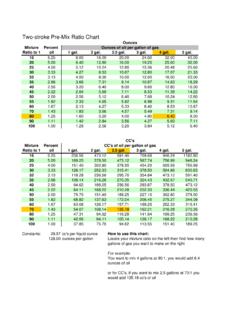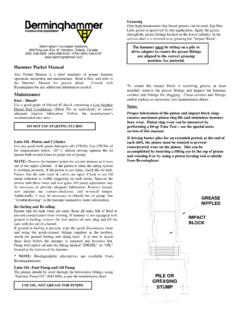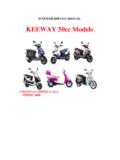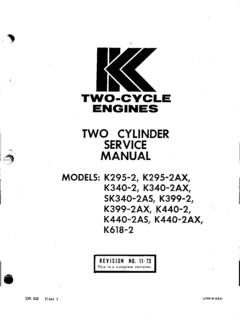Transcription of Racing Fuel Characteristics - IQ Learning Systems
1 The Finest Training Programs & Materials (800) 597-9747 Racing Fuel Characteristics The Four Primary Characteristics of Racing Fuels OCTANE is a measure of a fuel s resistance to pre-ignition, pinging, and detonation. There are three octane ratings for motor fuels; Research Octane Number (RON), Motor Octane Number (MON), and the average of the two (R+M/2). Of these three ratings, MON is the most useful to race engine builders because it is tested under load and higher RPM conditions. High MON ratings allow the use of higher compression ratios and more advanced spark timing.
2 However, there are other fuel Characteristics that influence the ability of a particular fuel to resist knocking. BURNING RATE is the speed at which a fuel burns and releases its heat energy. At higher RPM s there is less time for fuel to burn, so Racing fuels tend to work better if they have a rapid burning rate. If a fuel can be almost completely burned by the time the crankshaft is 20 degrees after TDC (Top Dead Center) on the engine power stroke, peak horsepower and engine efficiency are realized. LATENT HEAT of VAPORIZATION is the ability of a fuel to cool the intake charge and the combustion chamber.
3 It is often expressed as BTU s/gal (British Thermal Units per gallon). A fuel with a high latent heat value will do a better job of removing heat. This makes the intake charge more dense and packs more energy per volume into the engine. The cooling effect also helps control detonation and reduces the temperatures of engine and oiling system components. ENERGY VALUE is an expression of the total heat energy contained in a given amount of a fuel, expressed as British Thermal Units per pound (BTU/lb). The total amount of heat energy that is available to make horsepower depends on the Net Energy Value of the fuel.
4 This is found by taking the raw energy value of the fuel and then multiplying that by the amount of fuel that can be burned. The ideal air/fuel ratio for a fuel is called its stoichiometric. The lower the stoichiometric, the more fuel is burned and the more power can be produced. Fuel Octane (R+M/2) Octane (MON) Burning Rate (ms @ stoich.) Latent Heat (Btu/gal)Energy Value BTU/Lb Power Stoichio-metric Net Energy Mj/kg Boiling Point ( F) Pure Ethanol 113 102 .39 396 12,800 149 Pure Methanol N/A 103 .43 503 9,750 5/1 172 Pump Gasoline 86-93 80-90.
5 34 150 *ave. 18,700-19,100 130-430 Racing Gasoline, Sunoco 260 GTX N/A 99 N/A N/A N/A Est. 18,500 N/A 247 E-30 91-94 87-94 .36 337 (approx)17,178 (approx) 218 E-85 103-109 99-100 .38 359 (approx)14,021 (approx) 164 The Finest Training Programs & Materials (800) 597-9747 Racing Fuel Characteristics Fuel Characteristics Rankings The chart below reflects how various fuels rank in each of the four previously discussed categories.
6 Remember that the last column, Net Energy Value is the most important with regard to power making capabilities: Fuel Octane (MON) Burning Rate Latent Heat of Vaporization Net Energy Value Pure Ethanol 2 5 2 2 Pure Methanol 1 6 1 1 Pump Gasoline 6 2 6 5 Racing Gasoline, Sunoco 260 GTX 4 1 (estimated) 5 6 E-30 5 3 4 4 E-85 3 4 3 3 Advantages of Ethanol-Enriched Racing Fuels HORSEPOWER: Because Ethanol contains oxygen, it has a very low power stoichiometric when compared to gasoline fuels ( compared to ).
7 Ethanol must be run at much richer mixtures than gasoline, more than offsetting the lower energy per unit volume. The net energy released per cycle is higher and this results in more horsepower. For example, if a pound of gasoline is burned at its preferred max power air fuel mixture of , it will release approximately 19,000 BTU s of energy, where ethanol run at its preferred power stoichiometric of will release approximately 24,400 BTU s. By comparison, methanol releases slightly more, about 27,650 BTU s. The more ethanol there is in gasoline, the more powerful it is as a motor fuel. Typically, you can expect at least 5% more horsepower at the rear wheels of a vehicle running on E-85 than one burning gasoline only.
8 INCREASED ENGINE LIFE: Ethanol has a very high MON octane rating, allowing engine builders to run higher compression ratios without fears of destructive detonation. It also has a very high Latent Heat of Vaporization, so the engine is cooled far better than one running on gasoline. This lowers bottom end and oiling system temperatures substantially. REDUCED EMISSIONS: Although reducing emissions usually will not directly affect the on-track performance of a race car, engine parts like pistons and valves tend to stay cleaner. More importantly, there are serious health concerns with many of the octane boosting additives that must be added to Racing gasoline in order for them to be compatible with higher compression Racing engines.
9 Ethanol fumes are also non-toxic. FIRE SAFETY: While many factors enter into the causes of fuel fires, ethanol does enjoy certain advantages over gasoline fuels. The flame temperature for ethanol is lower, 1920 C compared to 2030 C for gasoline. Because it contains less heat energy than gasoline per volume, less total heat is released with ethanol when burning a given volume of fuel. The auto ignition temperature of ethanol is lower than that of many gasoline, 360 compared to up to 460 for gasoline. Liquid gasoline has vapors present at all temperatures, down to or exceeding -40 C. Ethanol has little or no vapor pressure below 13 C.
10 While pure ethanol fires have little or no color, even slight amounts of gasoline added to denature (poison) the mix create bright colors and dark smoke. The Finest Training Programs & Materials (800) 597-9747 Racing Fuel Characteristics Why Not Methanol? ETHANOL IS LESS CORROSIVE: Ethanol is less corrosive to most fuel delivery system components than methanol. This is due in part to the higher oxygen content of methanol. However, certain materials that may be used as sealers or glue in methanol-compatible fuel cells may not be compatible with ethanol. There are solutions to this problem that are being developed for the IRL (Indy Racing League) series that will be running pure ethanol in the 2007 season.





